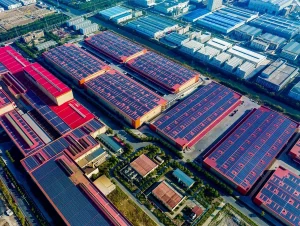
Sustainability has become integral to success in today’s fast-paced manufacturing landscape. Industries confront challenges like resource scarcity, environmental degradation, and evolving consumer preferences, necessitating a profound shift in business strategies. The concept of the ‘circular economy’ emerges as a transformative approach poised to revolutionize manufacturing, fostering economic growth while mitigating environmental impact.
It’s noteworthy that the term ‘circular economy’ isn’t new to India Inc. Its true measure lies in the extent to which it’s embraced and executed, aligning actions with its principles. Currently, its implementation lags behind discussions surrounding it and related concepts like ESG and sustainability. Non-renewable resources are swiftly depleting, affecting every one of the world’s eight-plus billion inhabitants.
The Imperative for Change: Rethinking Linear Models
The manufacturing industry is at a crossroads and has been for some time now, facing increasing pressure to reconcile economic prosperity with environmental responsibility. Traditional linear models of production characterized by a ‘take-make-waste’ mentality1 are no longer viable in a world where finite resources are rapidly depleting, and waste generation has already reached unprecedented levels with a plateau nowhere in sight. In this context, a circular economy offers a compelling alternative – a regenerative system that seeks to eliminate waste and maximize resource efficiency at every stage of the product lifecycle, essentially generating wealth from waste. According to the IBEF, the transition to a circular economy could generate an additional $4.5 trillion in global economic output by 20302. Bharat especially, has enormous potential for circular economy development. IBEF suggests our country could generate $218 billion annually and triple the same by 2050. By embracing ESG, businesses can unlock new opportunities, including enhanced employee productivity, better investments, and significant cost savings. The change in process is however, preceded by the change in thought process.
Redefining Production: Principles of the Circular Economy
At its core, the circular economy is about reimagining the way we design, produce, and consume goods. Innovation thrives when circular principles drive partnerships, fostering collaborations that reshape industries. Prominent alliances between tech giants and sustainable startups fuel productivity, merging cutting-edge technologies with eco-conscious practices. It challenges the traditional linear model by promoting strategies such as product redesign, material recycling, and resource recovery. By closing the loop on material flows, manufacturers can minimize waste, reduce environmental impact, and unlock new revenue streams. Moreover, embracing circular principles can enhance resilience against supply chain disruptions, regulatory pressures, and shifting consumer preferences, reducing manufacturing’s dependence on cyclicities.
Unlocking Opportunities: The Economic Potential of Circular Practices
According to projections, the global adoption of circular practices could generate trillions of dollars in economic output and create millions of new jobs by 20303. For Bharat, a country with immense growth potential and resource challenges, the circular economy represents a pathway to sustainable development and inclusive growth. By harnessing the power of circularity, Indian manufacturers can not only drive economic prosperity but also address pressing environmental and social issues. And this, is apart from the fact that this would definitely position us among the top-three nations to have made a sustainable, scalable shift – another defining moment for the New India, Bharat.
Circular manufacturing practices offer numerous global economic advantages, including reduced production costs, enhanced resource efficiency, and increased market competitiveness. By optimizing material usage, minimizing waste generation, and adopting innovative production techniques, manufacturers can improve operational efficiency whilst reducing their environmental footprint. Furthermore, circularity fosters innovation and fosters the development of new business models, products, and services, creating opportunities for revenue diversification and market expansion. In Peter Thiel’s words, it takes manufacturing from “zero to one”4.
Collaborative Action: Building an Enabling Environment
Achieving the full potential of the circular economy needs teamwork from everyone involved. Governments, businesses, and civil society must work together to create an environment where circular ideas and investments can thrive. This means making supportive rules, teaming up across different sectors, and putting money into research and development.
It’s essential for companies to think about the environment, society, and good governance when planning their business moves. This ensures they’re in line with sustainability goals and what people expect. Working together is key to making circular ideas big. Governments need to make rules that encourage recycling and sustainability, and they should buy products in a way that helps the environment. They also need to help with money and resources. At the same time, businesses need to focus on being sustainable in everything they do – from how they operate to how they make and sell products.
If companies build recycling and sustainability into their plans and how they make decisions, they can reduce risks, build a better reputation, and create more value for everyone. It might seem obvious, but sometimes, we’re the ones holding ourselves back on the path to a better future – because of our thoughts, the people we work with, and our struggle to see the big picture instead of just the short term.
Conclusion: Towards a Sustainable Future
The transition to a circular economy represents a historic opportunity for the manufacturing industry to redefine its relationship with the environment and society. By embracing circular principles and ESG initiatives, manufacturers can unlock new growth opportunities, drive innovation, and build a more resilient and sustainable future. As we navigate the challenges of the 21st century, a ‘circular economy’ offers a compelling vision for a world where economic prosperity goes hand in hand with environmental stewardship and social progress.
This now needs to move from thought to words, words which are not rhetoric or platitude, and then from words to action. Fast. After all, we can hardly live on Earth as if we have another planet to go to.
Partner With Us
The Institute for Sustainability Africa (INŚAF) is an independent multi-disciplinary think tank and research institute founded in Zimbabwe in 2010 with the Vision to advance sustainability initiatives for Africa.




